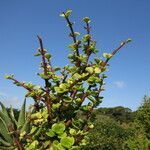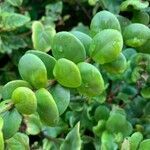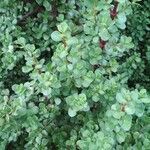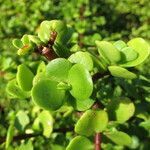Densely branched shrub or small tree 2–4 m high, branches brittle with jointed nodes; bark smooth, shiny, the twigs reddish-brown, older wood grey.. Leaves broadly obovate, glossy, very juicy, 1–2.5 cm long, 8–15 mm wide, rounded, sometimes apiculate, cuneate to a brief petiole.. Inflorescences terminal and axillary on the upper branchlets; flowers small, starry, produced in profusion, in fascicles racemosely arranged on an axis 3–7 cm long; pedicels slender, 2.5–5 mm long.. Sepals crescent-shaped, membranous, becoming rigid, 0.5–0.8 mm long; petals pale rosy-pink or mauve, narrowly obovate-oblong, slightly hooded, ± 2 mm long, subpersistent; stamens slightly longer than the petals, the filaments broadened downwards; ovary ellipsoid.. Fruit ellipsoid, 5 mm long, 3-angled, winged on the angles, translucent, glossy, pink, pendant.. Seed tear-shaped, 2 mm long, a narrow bilobed aril at the base.. Fig. 7 (p. 38).
Succulent, glabrous shrub with stout, sometimes waxy branches, 1-4 m high. Leaves opposite, succulent, obovate, white-waxy. Flowers ± 10, fascicled in membranous, depressed ovate bracts, on terminal branchlets. Sepals 2, membranous, becoming somewhat rigid, persistent. Petals connate into a short tube with 4 or 5 obovate lobes, pink to mauve. Stamens 4-7, adnate to petals; anthers often aborted. Ovary superior, 3-angled or narrowly 3-winged, 1-locular; ovule solitary, basal; style short; stigmas 3, slightly spreading. Flowering time Sept.-Feb. Fruit a thin-walled, 3-winged nut, indehiscent.
A small juicy leafed tree. It grows to about 1-4.5 m tall. The branches are grey and shiny. The new stems are reddish-brown. The roots are thick and clasp rocks. The leaves are flat and fleshy. They are simple and oval. They are slightly pointed and narrow to the base. They occur in opposite pairs at right angles down the twigs. The twigs are red. The leaves are edible. The flowers are star like and small. The flowers are pink or purple. The fruit is small and three winged. They are transparent and have a single seed inside. The leaves are edible.
Succulent shrub or small tree, up to 5 m high. Leaves fleshy, obovate, sessile. Small flowers produced in profusion, in dense sprays at ends of short lateral branchlets. Flowers pink to mauve.
Succulent shrub or small tree to 3 m. Leaves opposite, fleshy, obovate. Flowers in fascicles on terminal branches, pink.






